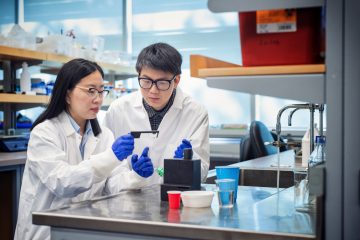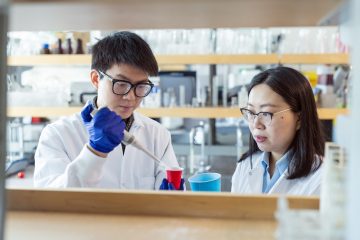A Fast Read on Plastics in Our Food and Water
A new portable tool can give you a precise reading on how much plastic could be seeping from your plastic coffee cup and into your body.
This device works in tandem with an app and uses fluorescent labeling of micro and nano plastics (MNPs) to detect plastic particles ranging in size from 50 nanometres (nm) to 10 microns (μm). Developed by Assistant Professor Tianxi Yang, this new invention has the potential to serve as a preliminary assessment tool to detect MNPs in real-world samples.
“Given the potential risks MNPs pose to both land-based and aquatic organisms, I am hoping this device can help facilitate the accurate assessment of plastics, and ultimately contribute to the safety and sustainability of ecosystems,” says Dr. Yang.

Her research team wanted to make current MNP measuring technology faster, more accessible, and more reliable. They built a small 3D-printed box from biodegradable materials to house the needed hardware: a wireless digital microscope that collects fluorescence signals, a green LED light, and an excitation filter. To measure the MNPs, the team customized MATLAB software with machine learning algorithms and integrated it with current image capture software.
The result is a portable tool, compatible with a smartphone or other mobile device, that gives a readout within 20 minutes. Importantly, the results can be understood by a non-technical person, such as someone working in a field, food processing lab, or just someone curious about their morning coffee.
The portable tool reads a small sample of liquid (1 microlitre), and then enables quantitative fluorescence imaging of MNPs.
“Once the portable box enables the fluorescent image, the app will readily correlate the pixel area of the image on the screen with quantity of MNPs. The readout indicates presence or absence of MNPs in the sample, and the quantity of MNPs in positive samples. Each test only costs as low as 1.5 cents.”
Dr. Yang’s team ran the first set of tests using disposable cups made with polystyrene (PS). Her team filled cups with 50 ml of boiling water that was allowed to cool for 30 minutes. The results showed that plastic particles were released from the cups at levels reaching hundreds of millions, primarily in the nano-size range.
Studies are growing into how much plastic we take in from sources that include drinking water, food, and even airborne plastic particles, as well as their long-term impact. One study indicates daily microplastic median intake rates for children are 553 particles/capita, and for adults it is 883 particles/capita (Lifetime Accumulation of Microplastic in Children and Adults, Nur Hazimah Mohamed Nor, Merel Kooi, Noël J. Diepens, and Albert A. Koelmans, Environ. Sci. Technol. 2021, 55 (8), 5084– 5096, Mar. 16, 2021).
“It’s well-known that large pieces of visible plastic can break down in various ways and leach into soils, water and get into our food system,” says Dr. Yang. “The accurate detection of MNP is critical in assessing their potential risk.”

“I would suggest, from a safety point of view, to reduce exposure to micro and nano plastics as long-term exposure can be linked to cognitive and health effects. Use cups and packaging made of glass or biodegradable materials, such as starch or those from food sources.”
Dr. Yang strives to improve agricultural and food systems and her interdisciplinary research combines food science, analytical chemistry, material science and nanotechnology. Other areas of her research are in precision agriculture, using smart agrochemicals that can respond to environmental stressors, like drought, extreme temperature or disease, and release on-demand. She is also creating new food packaging materials to improve food safety, quality, and upcycle food waste.
Tagged with: 2023, Faculty, Food Science
